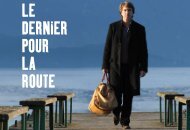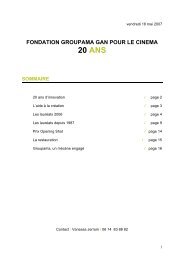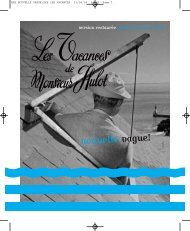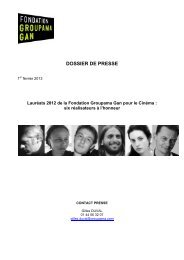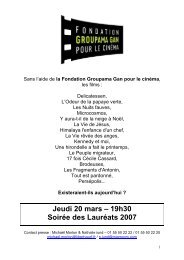duVoyage - Fondation Groupama Gan pour le Cinéma
duVoyage - Fondation Groupama Gan pour le Cinéma
duVoyage - Fondation Groupama Gan pour le Cinéma
You also want an ePaper? Increase the reach of your titles
YUMPU automatically turns print PDFs into web optimized ePapers that Google loves.
Histoire<br />
de la restauration<br />
Le Voyage dans la lune est proposé a sa sortie en 1902 en noir et blanc mais aussi en<br />
cou<strong>le</strong>ur. La version cou<strong>le</strong>ur, longtemps considérée comme perdue, est retrouvée en 1993<br />
par la Filmoteca de Catalunya, dans un état critique. À partir de 1999, des travaux extrêmement<br />
délicats débutent <strong>pour</strong> décol<strong>le</strong>r et numériser <strong>le</strong>s images. Il faut attendre 2010,<br />
<strong>pour</strong> qu’une restauration complète soit engagée, permettant de réassemb<strong>le</strong>r <strong>le</strong>s fragments<br />
des 13,375 images du film et de <strong>le</strong>s restaurer, une par une. Les images manquantes, perdues ou trop<br />
dégradées, ont été reprises de la version noir et blanc puis coloriées.<br />
« En 1999, nous avions eu la chance de retrouver 30 films de Georges Méliès. C’est en évoquant cette découverte<br />
avec <strong>le</strong> regretté Anton Gimenez, directeur de la Filmoteca de Catalunya à Barcelone, que nous apprîmes, au<br />
cours de la discussion, l’existence d’une copie cou<strong>le</strong>ur du Voyage dans la lune.<br />
La Filmoteca possédait bien cette copie, mais selon Gimenez, cel<strong>le</strong>-ci était tota<strong>le</strong>ment décomposée. Nous lui proposons<br />
alors de lui échanger cette ruine contre une copie d’un film perdu de Chomon. L’affaire est conclue et,<br />
quelque temps après, nous recevons une boîte contenant la précieuse relique. À l’intérieur se trouve une bobine<br />
de film 35mm ou nous pouvons distinguer <strong>le</strong>s premières images encadrées par de petites perforations caractéristiques<br />
des copies des premiers temps. Malheureusement notre ga<strong>le</strong>tte ressemb<strong>le</strong> d’avantage à une<br />
rondel<strong>le</strong> de bois, tant la décomposition à transformé la pellicu<strong>le</strong> soup<strong>le</strong> en une masse compacte et rigide. Nous<br />
décidons à notre tour de consulter plusieurs laboratoires spécialisés. Leur diagnostic est sans appel : la copie<br />
est définitivement perdue. Des lors, autant tenter notre chance. Armés d’un petit morceau de bristol soup<strong>le</strong><br />
et d’une infinie patience, nous avons commencé à séparer <strong>le</strong>s spires une à une. À notre grande surprise, la plupart<br />
des images n’étaient pas collées entre el<strong>le</strong>s. Seuls <strong>le</strong>s bords (la manchette) s’étaient décomposés et se trouvaient<br />
irrémédiab<strong>le</strong>ment soudés.<br />
Centimètre par centimètre nous avons progressé, dégageant parfois des bandes entières, mais souvent des petits<br />
fragments. Parfois, l’image avait même disparu. Il fallut plusieurs semaines <strong>pour</strong> révé<strong>le</strong>r la presque totalité des<br />
images. La bobine déroulée, el<strong>le</strong> demeurait cependant d’une fragilité extrême. Dans cet état, il était inimaginab<strong>le</strong><br />
de la passer sur une tireuse alternative en immersion, seu<strong>le</strong> technique permettant de recopier <strong>le</strong>s images sur un<br />
nouveau support de sauvegarde avant restauration. Deux options s’offraient donc à nous. Soit essayer de rendre<br />
sa soup<strong>le</strong>sse d’origine au support afin de <strong>le</strong> faire passer dans la tireuse, soit photographier au banc-titre chaque<br />
image au risque de <strong>le</strong>s briser. La première solution nécessitait un traitement chimique qui pouvait rendre sa soup<strong>le</strong>sse<br />
au support <strong>pour</strong> une courte durée, mais qui malheureusement accélérait par la suite la décomposition. La<br />
seconde solution allait entraîner de nombreuses déchirures et était délicate et longue. Nous nous sommes retrouvés<br />
contraints de nous tourner vers <strong>le</strong> traitement chimique. La copie a été envoyée au laboratoire Haghefilm,<br />
où el<strong>le</strong> allait être placée durant plusieurs semaines sous une cloche de verre, soumise au vapeurs d’un mélange<br />
chimique mis au point dans <strong>le</strong>s laboratoires des Archives Françaises du Film. Après plusieurs mois d’effort, près<br />
d’un tiers du film fût ainsi sauvegardé sur pellicu<strong>le</strong> internégative. Il devenait enfin possib<strong>le</strong> de revoir ces<br />
images en cou<strong>le</strong>ur. Cependant, l’autre moitié du film, qui n’avait pu passer dans la tireuse, nous était rendue<br />
sous forme de fragments informes, que <strong>le</strong> séjour prolongé dans <strong>le</strong>s vapeurs chimiques avait rendu encore plus<br />
cassants.<br />
Début 2000, c’est armé d'un nouvel appareil photo numerique d’une définition de 3 millions de pixel que nous<br />
avons photographié <strong>le</strong>s images survivantes. Un an d’effort fût nécessaire <strong>pour</strong> sauvegarder <strong>le</strong>s 5.000 dernières<br />
pièces de ce gigantesque puzz<strong>le</strong> (qui en compte plus du doub<strong>le</strong>). 10 ans ont passé. L’assemblage du puzz<strong>le</strong> pouvait<br />
enfin commencer ».<br />
182<br />
Story<br />
of a restoration<br />
ATrip to the Moon was made availab<strong>le</strong> on its re<strong>le</strong>ase in black and white but also in<br />
colour. The colour version, long considered lost, was found in 1993 by the Filmoteca<br />
de Catalunya in a critical state. In 1999 extremely delicate work started to separate<br />
and digitalize the images. It was not until 2010 that a comp<strong>le</strong>te restoration was<br />
begun, enabling the fragments of 13,375 mages from the film to be reassemb<strong>le</strong>d<br />
and restored, one by one. Images that were missing, lost or damaged were taken from the black<br />
and white version, then colorised.<br />
«In 1999, we were lucky to find 30 films by Georges Méliès. It was by mentioning this discovery to the much<br />
missed Anton Gimenez, then director of the Filmoteca de Catalunya in Barcelona, that we <strong>le</strong>arned in the course<br />
of our discussion with him about the existence of a colour copy of A Trip to the Moon.<br />
The Filmoteca had this copy, but according to Gimenez, it was in a state of total decomposition. We offered to<br />
exchange his ruined Méliès for a copy of a lost film by Chomon. The deal was done, and some time later, we<br />
received a case containing the precious relic. Inside, there was a 35mm film on which we could distinguish<br />
some of the first film images framed by the small perforations characteristic of early films. Unfortunately, our<br />
round reel looked more like a ring of wood, such was the extent to which decomposition had transformed the<br />
originally supp<strong>le</strong> film into a rigid, compact mass. We decided to consult several specialist laboratories. Their<br />
diagnosis was irrevocab<strong>le</strong>: the copy was lost. From that point on, we had nothing to lose. Armed with a small<br />
piece of f<strong>le</strong>xib<strong>le</strong> card and infinite patience, we started to separate the film spires one by one. Much to our surprise,<br />
most of the images were not stuck one to the other. Only the sides themselves had decomposed and were<br />
irremediably welded together.<br />
We progressed centimetre by centimetre, taking out entire strips of film at a time but often in small fragments.<br />
Sometimes the image had disappeared. It took several weeks to uncover the quasi-totality of the images.<br />
The reel, now unwound, was still extremely fragi<strong>le</strong>. In its condition, it was unthinkab<strong>le</strong> that we could use wet<br />
gate step printing, the only technique that would enab<strong>le</strong> the images to be copied again onto a new film before<br />
they could be restored. We had two options. Either we tried to give the film back its original f<strong>le</strong>xibility so that<br />
it could be duplicated, or we photographed each image using an animation stand, but at the risk of breaking<br />
the film.<br />
The first solution required chemical treatment which would render the film pliab<strong>le</strong> for a short period, but<br />
which would unfortunately acce<strong>le</strong>rate its decomposition subsequently. The second solution would <strong>le</strong>ad to numerous<br />
tears and would be delicate and long. We found ourselves forced to consider chemical treatment. The<br />
copy was sent to the Haghefilm laboratory, where it was place for several weeks under a glass bell, subjected<br />
to va<strong>pour</strong>s of a chemical mix developed by the Archives Françaises du Film. After several months of effort, nearly<br />
a third of the film was saved onto an inter-negative film. Finally it was possib<strong>le</strong> to view these images in colour.<br />
However, the other half of the film, which we were not ab<strong>le</strong> to put through the printer, was given back to us<br />
in form<strong>le</strong>ss fragments that the prolonged stay in chemical va<strong>pour</strong>s had made even more britt<strong>le</strong>.<br />
At the beginning of 2000, using a new 3 million pixel digital camera, we photographed the surviving images.<br />
A year of work was necessary to save the 5,000 last pieces of this gigantic puzz<strong>le</strong> (which has more than doub<strong>le</strong><br />
that number in total). 10 years passed. And the piecing together of the puzz<strong>le</strong> could finally begin.»<br />
Serge Bromberg & Eric Lange (Lobster Films)<br />
183



